
Lifestyle
Microplastics Found in Bottled Water
A recent analysis of the world’s most popular bottled water brands found that more than 90% of them contained microplastics, prompting the World Health Organization to launch a review into the potential risks of ingestion.
The study analyzed 259 bottles of water from nine locations and 11 different brands. Of the 259 bottles tested, only 17 were devoid of microplastic particles. In one Nestle Pure Life bottle, researchers found a concentration of 10,000 plastic pieces per liter of water.
Americans who exclusively drink water from plastic bottles are ingesting up to 90,000 microplastic particles every year. The average human consumed microplastics from a variety of sources, including food, breathing air, and drinking water, but they have been found in higher concentrations in bottled water.

The most common type of plastic particles found in bottled water was polypropylene, a type of plastic used to manufacture bottle caps. To determine the amount of plastic particles in each bottle, researchers used red dye to fluoresce the water, as the dye will stick to the surface of plastics.
The potential health impacts of ingesting microplastic particles have yet to be determined, but the issue is becoming an area of concern with the World Health Organization. The amount of quality data on the health risks posed by microplastics is severely limited. Some research shows that microplastics can be absorbed into gut tissue, but how this affects this area has yet to be determined.
Microplastics are already found in extremely high concentrations throughout the ocean. They have been found to harm marine life in a number of ways, with the chemicals contained within these particles causing damage to the endocrine and lymphatic system of many different types of animals.
In one particularly gruesome example, a dead sperm whale that washed ashore last year on the Italian island of Sardinia was found to have 48 pounds of plastic in its stomach, much of it including microplastic particles and even larger objects like plastic bags.
While the fact that we are ingesting microplastic particles at an alarming rate is disturbing, there is little to do until we can determine the long-term health effects it poses on humans.





0 comments